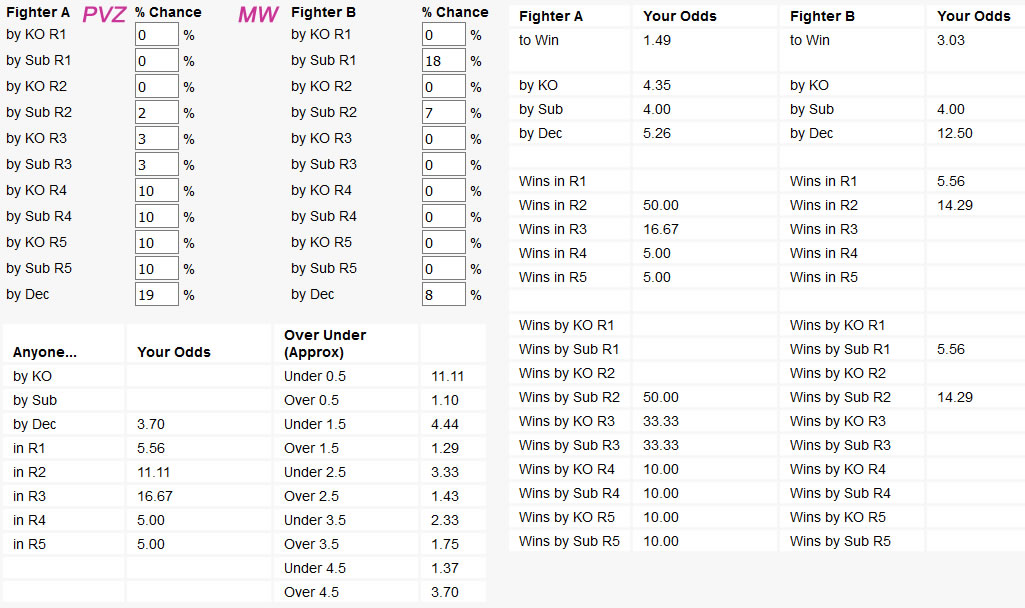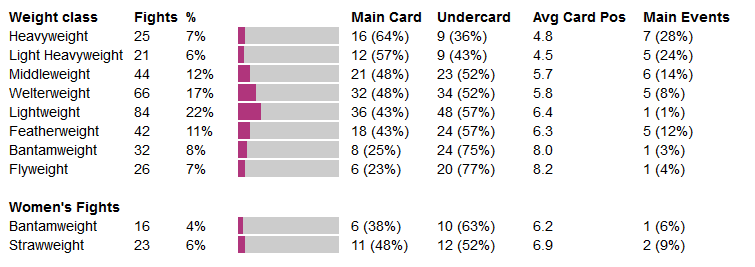If you’re gunna call me a “pissant nobody”, imply I have a small penis then tell everyone to avoid doing business with me, just cos I politely disagreed with your article, you should probably expect some sort of response. Here it is 🙂
To make it worth reading for everyone else, this isn’t just a blog to defend myself in this petty beef; I’ll include some interesting stats too!
Anyway, Jonathan Snowden, lead combat writer for Bleacher report, wrote this article on Women’s MMA in the UFC. Basically it said that the UFC don’t put women high enough up on the card and they are treated unfairly / not given enough air time.
I disagree with that point and politely said so on twitter. It escalated on his part, he started insulting me, then deleted all the stuff where he acted like a douche and told people not to do business with me.
Well, that’s not cool, so I thought I’d note down as much of the convo as I could and post it up. You’ll have to take my word for it this is what he said. My side is verifiable in my “Tweets and replies” but you won’t find his messages anywhere. I copied the ones I got an email notification for but I didn’t get a notification for all of them (dunno why… maybe he deleted them really quickly). Anyway, here it is;
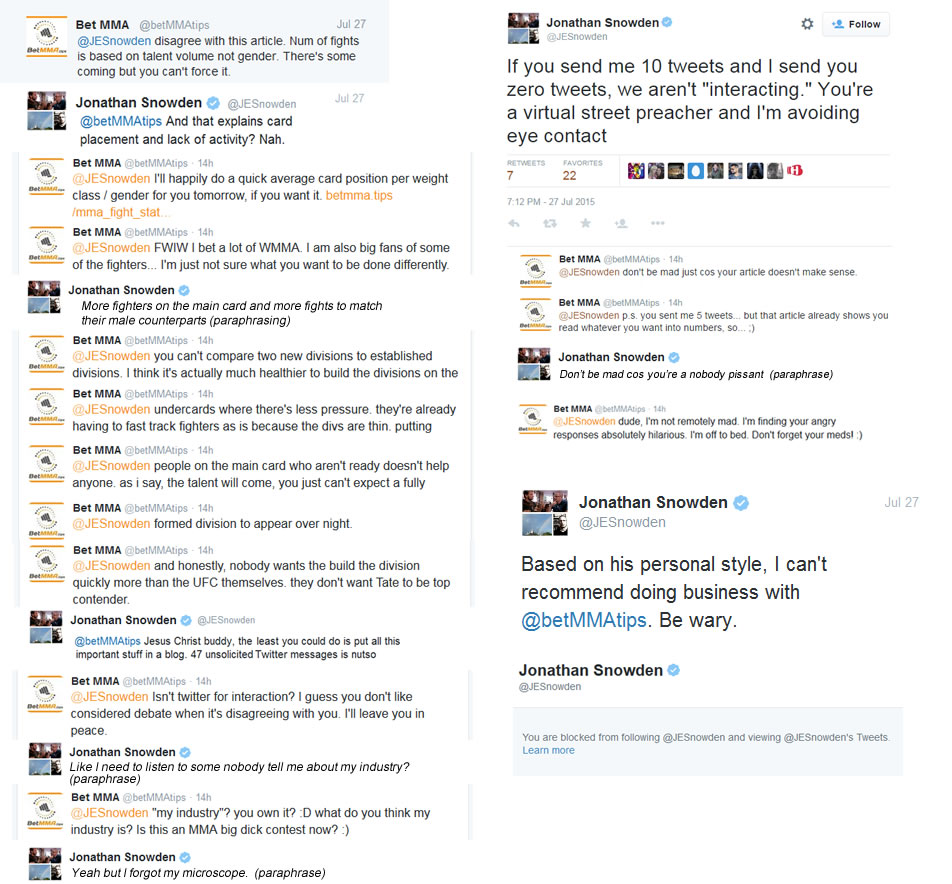
twitter conversation with Jonathan Snowden
So yeah, that was weird!
He mentioned in another tweet at the same time that he’s having a tough week with some personal stuff, which sucks and I hope that all works out as best as possible. That doesn’t mean you get to tell people not to do business with me, when it was you who had a complete hissy fit over a very vanilla difference of opinions!
I’m not in this industry to get involved in beef. If he wants to make up, that’s cool by me. I know sometimes people go way over the top and act inappropriately.
Anyway, forget that… I’m just posting it effectively to document my side of the story, for anyone who actually reads that tweet saying not to do business with me. The interesting part is actually the UFC’s treatment of Women’s MMA, so let’s have a look at that.
UFC treatment of Women’s MMA
As someone who’s spent a lot of time watching WMMA lately, I think the UFC do a perfectly good job. I’m no UFC apologist by any means… I think they are distastefully and unnecessarly ruthless on a lot of issues and I think that brutal attitude to business is what causes a lot of people to write unjustly critical blogs, like Jonathan’s.
This is the general gist of the article by Jonathan.
“The sad truth is that despite a lack of interest in a Tate-versus-Rousey trilogy, it’s the best women’s bantamweight fight the UFC has to offer—and a problem they’ve created for themselves by all but ignoring women’s MMA. UFC, for all the progress made and the courage shown bringing women into the fold, still doesn’t seem fully committed to the experiment.
The promotion, quite obviously, is fully invested in the Ronda Rousey business. Women’s MMA, generally, hasn’t gotten the same love. According to Bleacher Report’s research, fewer than 10 percent of all UFC fights so far in 2015 have featured women, making both women’s bantamweight and the new strawweight division the least active divisions in the sport.
The UFC has a once-in-a-lifetime talent in Rousey….. UFC is failing her by letting the bantamweight division fall to pieces around her. Want to find the next Rousey? She won’t be the woman flailing away on Fight Pass or sitting at home waiting for a call.”
My response:
Yep, Tate vs Rousey 3 is the best we have to offer. Yep, that kinda sucks. That isn’t REMOTELY to do with where on the card women fight and to suggest that is nonsense. Jonathan states himself that Rousey is a once in a lifetime talent. THAT’s why the UFC are, quite understandably, having problems finding her competitive matchups!
If a fighter isn’t good enough to beat (or even compete with) Rousey, fighting higher up the card isn’t going to change that.
The UFC are already fast tracking talent to their main card faster than they would in other, more established divisions. Holly Holm was a co-main event in her first UFC fight. She looked fairly laclustre. In her second bout, again on the main card, she looked much better. I have no doubt she would have benefitted from a less high profile introduction to the UFC.
Paige VanZant looked very sloppy in her UFC debut (on the undercard) but was fast tracked to the main card in her next fight and looked a fair bit better. Still, in terms of actual talent, I’d argue she is being pushed well ahead of where she deserves to be in terms of card position, based on the UFCs desire to fast track the womens’ divisions into a more mature and developed state (i.e. exactly what Jonathan claims they’re not doing).
Looking at things from the other side; are there many women who deserve to be on the main card who aren’t? Surely that’s the obvious question to ask, rather than blindly looking at stats and trying to draw inaccurate cause and effect assumptions.
I can only think of MAYBE one and that’s Valerie Letourneau. She’s only had 2 UFC fights and I think she’s a solid talent. She’ll be main (or maybe co-main) eventing the undercard on Aug 23rd. Holloway vs Oliveira. She’s a good fighter but even then, she should be perfectly content with a solid position on the undercard.
Don’t underestimate the quality of fighters down there. Aljamain Sterling has only fought on the undercard so far (3 times). He’s vastly superior as a prospect to anything WMMA has to offer… It’s really not an insult to be out of the spotlight – rather it’s exactly what an up and coming MMA fighter should want and expect, as they build up their skillset. Throwing people in above their head (exposure wise or in terms of competition) is a great way to get them to under-perform and consequently have people write them off. Once a fighter’s been written off, it’s a lot harder to build that hype back up again!
A good example of that would see us going back to Holly Holm. I think she’s probably going to be the best short-medium term threat to Rousey. If she’d been given a bit of an easier entrance into the UFC, I think she could have been further along the line to justifying a title fight and certainly, with a couple of finishes on her record as opposed to a couple of decisions, the UFC would have less of a problem hyping that fight. As it is now, nobody’s going to want to see that fight either and it’s because they’ve had to fast track her to relatively tough opposition.
So anyway, let’s have a quick look at what I believe to be irrelevant stats, quoted by Jonathan… How many fights have there been in each weight class, on the main event of cards?
*NOTE…. I’m programming this as I write the blog. All the blog above was just my opinion, so let’s see what the facts say.
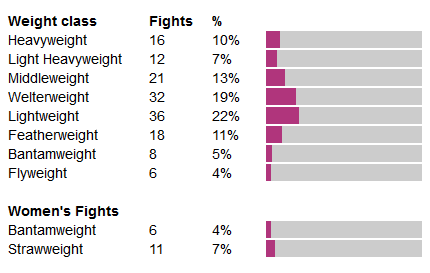
Fights on main UFC card by weight class since Nov ’14. Table from our MMA fight stats page (filter UFC fights only).
Since we started logging fights in Nov 14, there have been more Women’s Strawweight fights than male Bantamweight and Flyweight fights. By Jonathan’s logic, you can say the UFC are “all but ignoring” those weight classes. There’s also basically the same amount of fights in the light heavyweight division, which has historically been the UFCs marquee division!
As I said in my tweets to him, really, the actual reason is just the amount of talent. You can’t force these things… If there aren’t enough fighters in a weight class, male or female, you can’t make the fights!
Demetrious Johnson will be fighting John Dodson in his next title fight. Dodson’s last fight was absolutely horrible but there just aren’t enough human beings (and consequently fighters) at 125lbs, to find any other title contenders. It’s nothing to do with the UFC neglecting the division.
I could post a bell curve of the size of human beings and it would basically be exactly the same as the above graph… Men are generally 155-170lbs (when they aren’t stuffing their faces with McDonalds), so unsurprisingly, those divisions have the most fights. Likewise, there are more women who, when in shape, weight around 115-125lbs than 135-145lbs, so there are more 115lb women’s fights… It’s no conspiracy or negligence from the UFC, it’s just human biology.
So in response to this article, I decided to program a new page, to work out the average fight card position for each weight class and how many fights were main card vs undercard. As you can see from the table below, the UFC (since Nov 2014) has somewhat over-sold the heavyweight and light-heavyweight divisions but other than that, it’s much of a muchness. Women’s strawweight actually has the third most fights on the main card, as a percentage of overall fights in the division. If you wanna pick divisions that have been neglected, it’s clearly the mens 135 and 125lbers, as evidenced by the UFC being forced to use Dodson again (as mentioned earlier).
One other thing I wanted to do was to look at how many fighters are making their debut in each of these divisions. Obviously fighters making their debut don’t get put on main cards (very often) and given that the women’s divisions (particularly the 115lb division) are new, you’re going to get a lot more debuts!
Below is a table of fights where one or more of the fighters were making their UFC debuts.
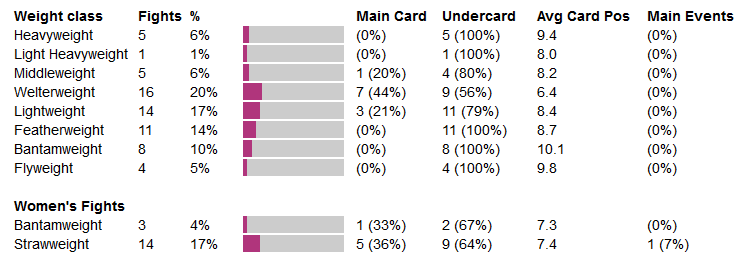
Average card position for fights where one or both fighters is making their UFC debut
As you can see, the women’s fights get a much higher number of fights put straight onto the main card. Their average card position is the 2nd and 3rd highest of any weight class in the entire UFC (only welterweight is higher). Completely contrary to the criticism in the original Bleacher Report article.
One thing that is definitely apparent; there aren’t a massive amount of fighters making their debuts in quite a lot of the divisions. Light heavyweight only has one!
The thing is, all this sort of stuff is cyclical. Our stats are only since November. The original Bleacher Report article was only taking stats from 2015. That’s far too short of a sample size. We had a women’s 135lb division TUF which finished in November 2013, so if we’d done this table last year, it would look a lot more like the UFC “cared” a lot more about 135lb women’s fights.
That’s the problem with stats; if you don’t look at them in an appropriate context, you can make them say whatever you want.
My suggestion as someone who’s basically made a living from stats for the last 6 years, first by running MMA Tycoon and now with Bet MMA; look for interesting stats, then ask yourself first and foremost, why are these stats probably misleading? If you can’t think of any reason they’re misleading, well then you may just have found an interesting trend!
So going back to the original point of the article? Are the UFC neglecting and ignoring women’s MMA?
No, of course not. Fundamentally that would make zero sense and you don’t need stats to back that up. Rousey is probably (I have no idea, I’m just guessing), the UFC’s second highest PPV draw? Their PPV ratings have been dropping pretty steadily over the last few years so they need Rousey and whether you like them or not, the UFC aren’t dumb. They know they need contenders for her.
As I said in one tweet, the UFC REALLY don’t want Meisha Tate to be top contender but the division is just threadbare, throughout the entire MMA world, not just in the UFC. The UFC already signed pretty much all of the top fighters and they’re trying to build up more in Invicta. This isn’t the old Pride era, with fragmented talent… What you see in the UFC rankings is basically it.
On a more positive note, in a division with more talent (female 115lbs), they’re bringing in a lot more new fighters (more than any other division) and pushing those new fighters beyond what they’ve done in all but 1 of the male divisions in terms of general card position and number of fights on the main card.
You can’t illustrate that fact much clearler than the table below. Does that look like they’re “all but ignoring” women’s MMA to you?
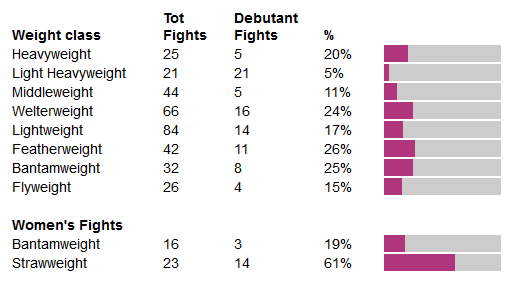
Debutant fights in each UFC weight class as a % of total fights
Summary
Jonathan, I hope whatever problem you’re dealing with sorts itself out and I’m sorry to hear you’ve got some problems to deal with at all, however it’s not cool to tell people not to deal with me just because I disagreed with you. I have no idea if you’re a nice guy or not. If you are I’m sure you’ll accept you massively over-reacted and were out of order and will retract that comment. If you wanna leave it up, no worries, shit happens… but that would be a complete douchebag move.
In terms of the stats. There are a hell of a lot of interesting statistical trends to look at in MMA. I’m developing more and more all the time. You can view all that via our MMA Stats page.
A few interesting ones related to Women’s MMA
– There are significantly more finishes at 135lbs than 115lbs. (Currently 56%, despite a recent run of decisions).
– Joanne Calderwood beating Cortney Casey was the first women’s fight opening a UFC main card not to have finished as a decision.
– The 115lbs division has 57% decisions overall (2nd most, only behind the men’s 125lb division).
– And finally, a quick comparison graph of finishes / decisions for men vs women’s MMA fights. As you can see, there are a lot more subs in WMMA and also a more even spread of round finishes (i.e. not so heavily skewed towards R1 finishes). I have my theories about why but you’re welcome to play around with the stats yourself here. Start by removing heavyweight from the stats and you’ll see a massive drop in R1 finishes! Compare that to the women’s fights and you can see the TKOs are more from an accumulation of damage in the later rounds.
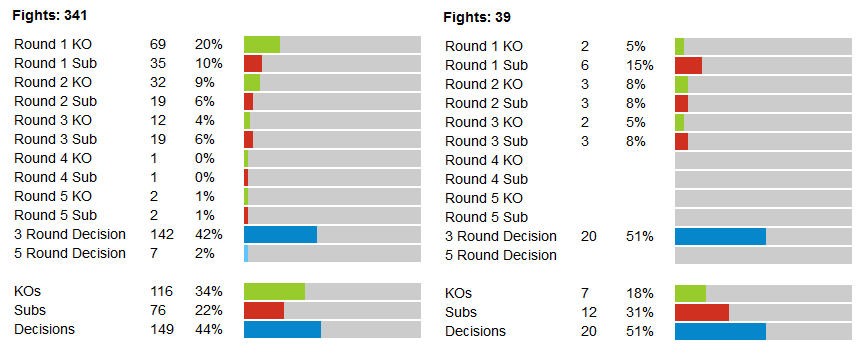
Men vs Women MMA stats
Thanks for your time and happy MMAing… or something like that! Oh and be nice to each other… We’re all fans of the same sport, whether we agree with each other or not!


